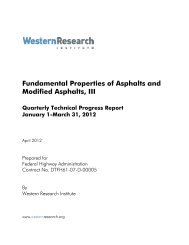Fundamental Properties of Asphalts and Modified Asphalts, III
Fundamental Properties of Asphalts and Modified Asphalts, III
Fundamental Properties of Asphalts and Modified Asphalts, III
You also want an ePaper? Increase the reach of your titles
YUMPU automatically turns print PDFs into web optimized ePapers that Google loves.
All different aging times were shifted to zero aging time. The aging shift factor is the amount <strong>of</strong><br />
shift <strong>of</strong> the complex modulus at a given aging time to the reference aging time (zero aging time<br />
in this case) to form a single curve. The values <strong>of</strong> these shift factors can be considered to be<br />
modulus (stiffness) changes with respect to the modulus at the reference aging time, <strong>and</strong> give an<br />
indication <strong>of</strong> how the properties <strong>of</strong> a material change with aging time.<br />
Figure 2-5.1 also shows the constructed complex modulus oxidation master curve for asphalt<br />
ABD mixed with 1.5% PPA with respect to different aging times. A well-defined curve can be<br />
seen in the figure indicating that a similarity does exist between the effects <strong>of</strong> aging <strong>and</strong><br />
temperature. The logarithm <strong>of</strong> the aging shift factor is the amount <strong>of</strong> shift for the complex<br />
modulus at a given aging time to the reference aging time to form a single curve. Figure 2-5.2<br />
shows the shift factor as a function <strong>of</strong> PAV aging time for asphalt ABD <strong>and</strong> PPA-modified ABD<br />
aged in the absence <strong>and</strong> presence <strong>of</strong> water.<br />
As seen from figure 2-5.2, the curve <strong>of</strong> the aging shift factor is similar to that <strong>of</strong> viscosity-aging<br />
kinetic curves for typical asphalts <strong>and</strong> is shear rate independent. On oxidation, asphalts show an<br />
initial rapid rate <strong>of</strong> viscosity increase followed by a slower rate <strong>of</strong> viscosity increase. This<br />
behavior has been attributed to the formation <strong>of</strong> sulfoxide <strong>and</strong> carbonyl products in the oxidation<br />
process <strong>of</strong> asphalt binder when exposed to atmospheric oxygen in the pavement. As seen from<br />
figure 2-5.2, addition <strong>of</strong> PPA to asphalts increases the amount <strong>of</strong> stiffness change with respect to<br />
the stiffness at the reference aging time, indicating that addition <strong>of</strong> PPA has changed the aging<br />
characteristics <strong>of</strong> asphalt binders. In addition, aging in the presence <strong>of</strong> water reduces the amount<br />
<strong>of</strong> stiffness change with respect to the stiffness at the reference aging time for neat unmodified<br />
asphalts. However, addition <strong>of</strong> water in the pressure aging oven increases the amount <strong>of</strong><br />
stiffness change for PPA modified asphalt binders.<br />
Figures 2-5.3 <strong>and</strong> 2-5.4 show similar types <strong>of</strong> plots, aging shift factors versus PAV aging times<br />
in the presence <strong>and</strong> absence <strong>of</strong> water, for asphalts AAD-1, AAM-1, <strong>and</strong> their PPA mixtures,<br />
respectively. Again, it can be seen that addition <strong>of</strong> PPA to asphalts increases the amount <strong>of</strong><br />
stiffness change due to PAV aging. As seen from both figures 2-5.3 <strong>and</strong> 2-5.4, the aging shift<br />
factors <strong>of</strong> PPA modified asphalts after PAV aging for 326 hours in the presence <strong>of</strong> water are<br />
similar to those <strong>of</strong> the same PPA modified asphalts at the same aging time in the absence <strong>of</strong><br />
water. This suggests that PPA modified asphalts AAD-1 <strong>and</strong> AAM-1 aged at 326 hours in the<br />
PAV in the presence <strong>of</strong> water have similar complex modulus to the same materials that were<br />
subjected to the same aging time in the absence <strong>of</strong> water. However, it is uncertain if the reduced<br />
complex modulus at the end <strong>of</strong> aging time <strong>of</strong> 326 hours in the presence <strong>of</strong> water is due to the<br />
presence <strong>of</strong> moisture during PAV aging or experiment error. Nonetheless, more experiments<br />
need to be conducted to verify this observation.<br />
During the quarter, work also continued on the study <strong>of</strong> the behavior <strong>of</strong> phosphorous containing<br />
additives in asphalt by using NMR techniques. In particular, NMR work continued on<br />
characterizing the behavior <strong>of</strong> phosphate ester <strong>and</strong> amine antistrip agents in asphalt. In addition,<br />
some exploratory measurements were made to determine the feasibility <strong>of</strong> using 31 P NMR to<br />
determine moisture in asphalt.<br />
60





